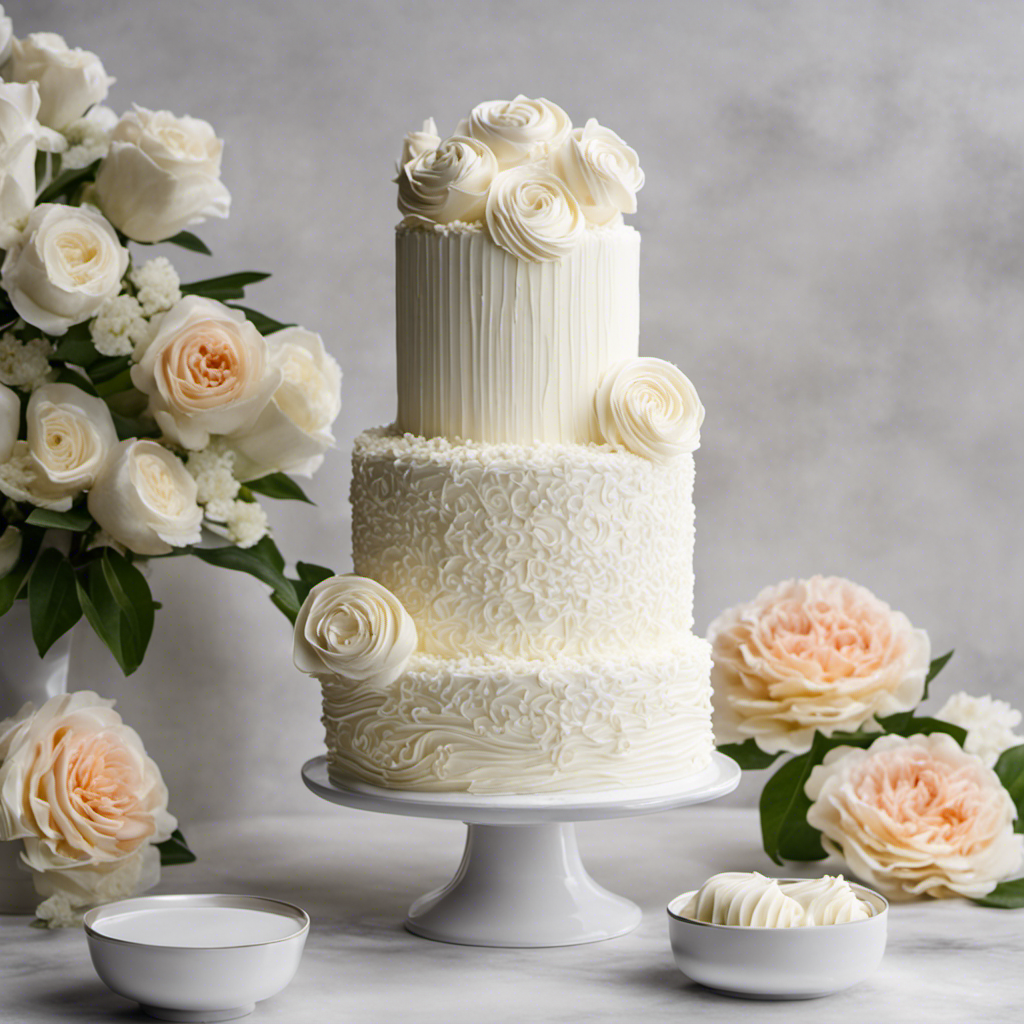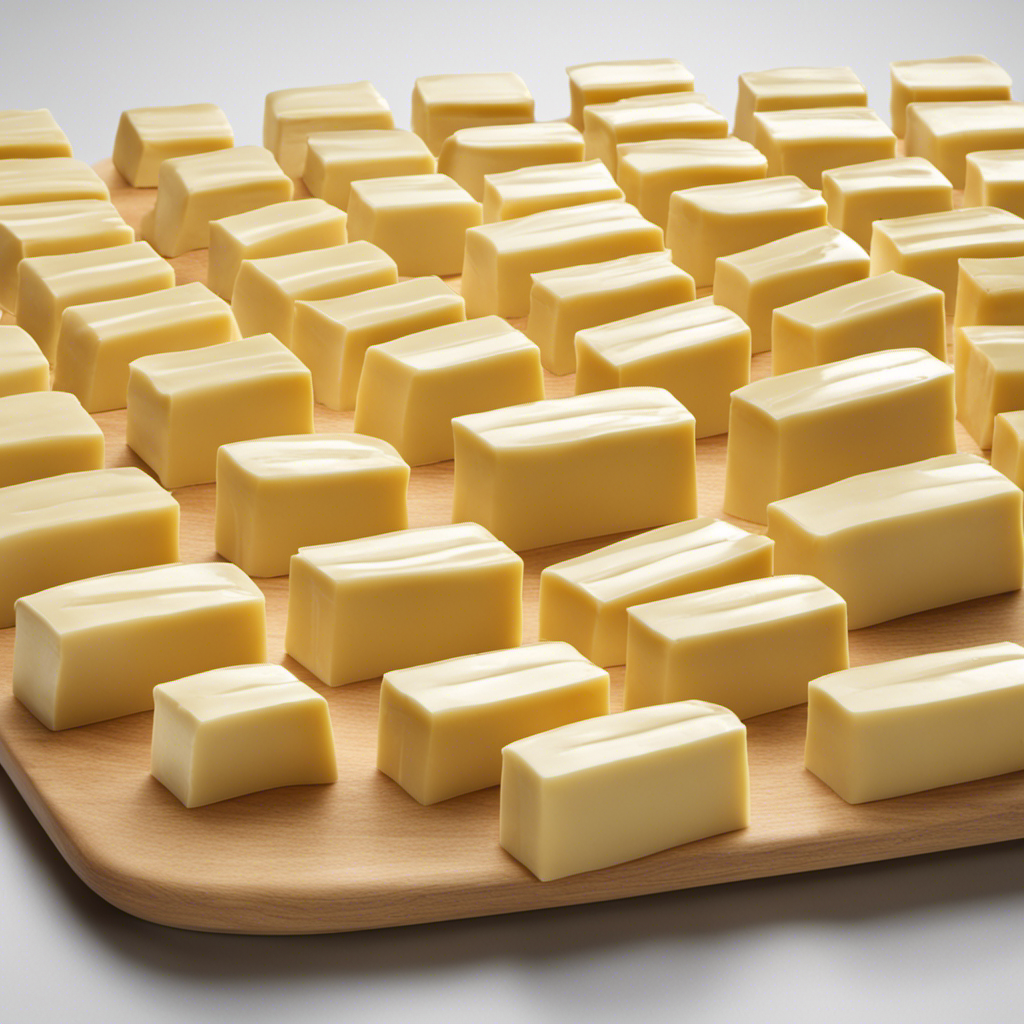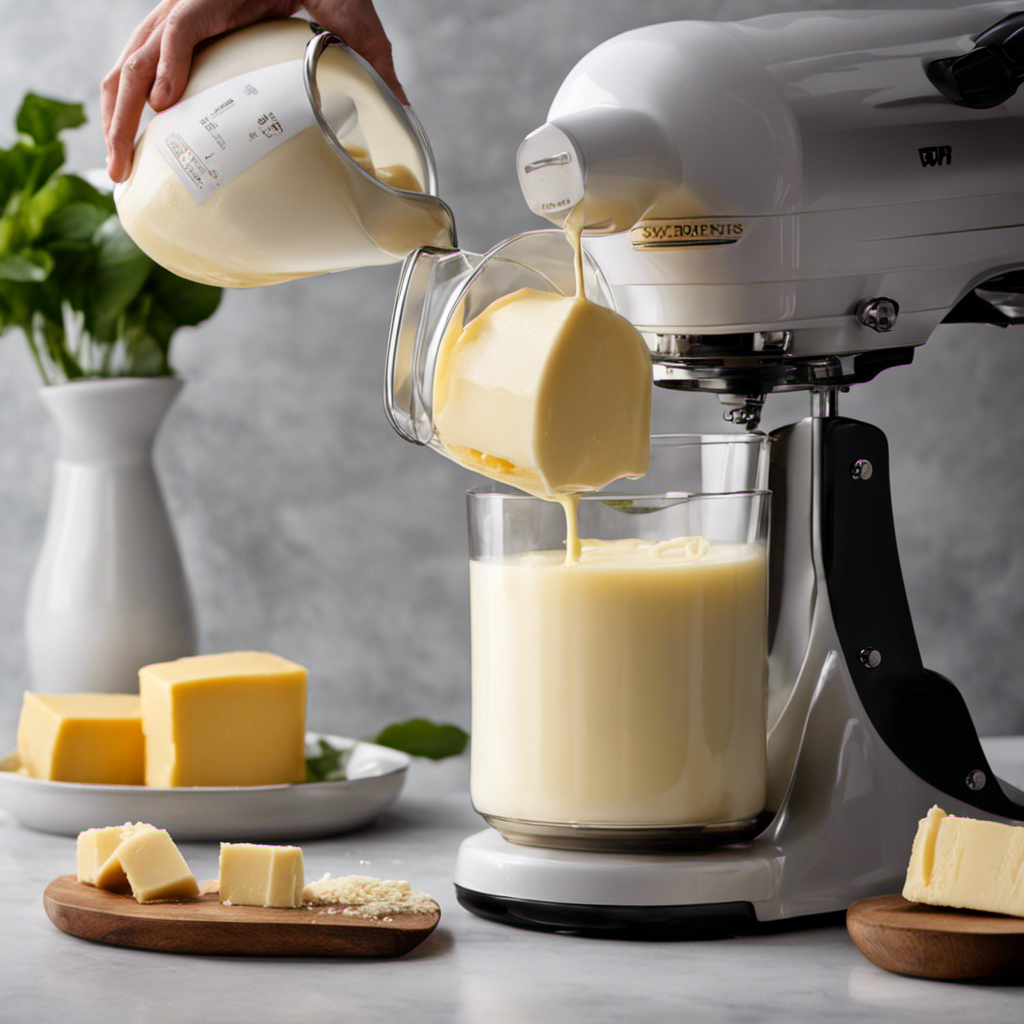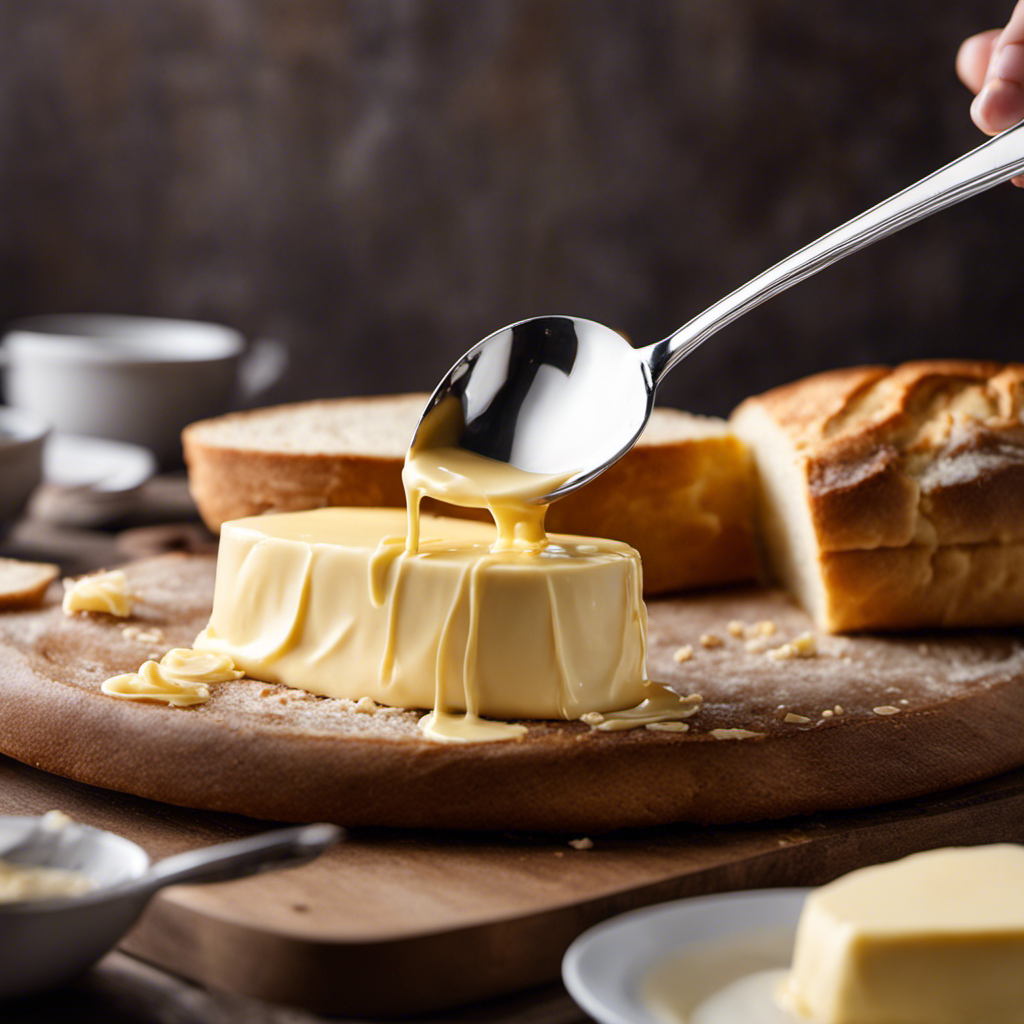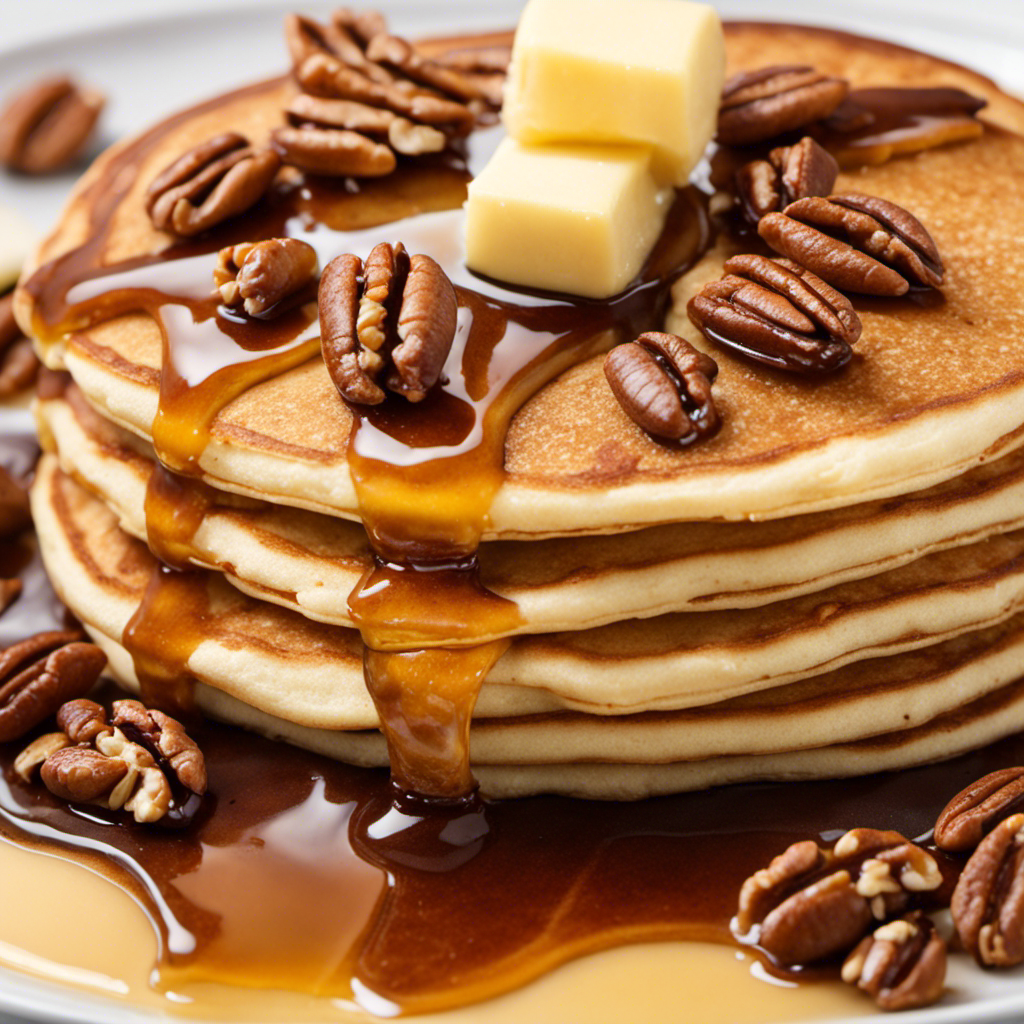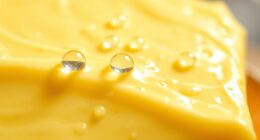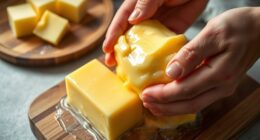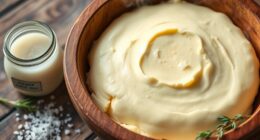I’ve always been mesmerized by the pristine, snowy white appearance of buttercream frosting. There is something irresistibly appealing about a flawlessly white, smooth finish on a cake or cupcake.
In this article, I’ll share my tried and true method for achieving that pristine white color every time. We’ll dive into the key ingredients, step-by-step mixing instructions, and even explore some tips and tricks for making your icing even whiter.
Get ready to elevate your baking game and create stunning, white butter cream icing that will leave everyone in awe.
Key Takeaways
- Start with a pure white base recipe using unsalted butter or neutral vegetable shortening.
- Gradually add white food coloring, evaluating the color after each addition.
- Experiment with alternative natural ingredients like lemon juice, yogurt, sour cream, coconut milk, or almond milk to achieve a whiter shade.
- Avoid artificial additives.
Ingredients for White Butter Cream Icing
To make white butter cream icing, you’ll need a few key ingredients. The traditional recipe calls for butter, powdered sugar, vanilla extract, and milk. However, there are alternative recipes that use shortening instead of butter for a whiter appearance.
Troubleshooting tips come in handy when trying to achieve the perfect white icing. One common issue is the icing turning out yellowish instead of white. This can be caused by using regular butter instead of unsalted butter, which has a higher water content.
Another tip is to use clear vanilla extract instead of the regular one, as it won’t affect the color of the icing. Finally, sifting the powdered sugar before adding it to the mixture helps to avoid any lumps and ensures a smooth and white butter cream icing.
Step-by-Step Mixing Instructions
When it comes to achieving a pure white buttercream icing, there are a few key points to consider.
First, using the right ingredients is crucial for achieving that pristine white color. However, if you find yourself without some of the necessary ingredients, there are also substitutions you can use to maintain the whiteness of your icing.
Lastly, there are common mistakes that can easily be avoided, such as overmixing or using ingredients that are not at room temperature.
Achieving Pure White
You can achieve a pure white butter cream icing by using clear vanilla extract instead of the regular one. Here are four ways to naturally whiten your butter cream icing:
-
Use coconut milk: Substitute regular milk with coconut milk in your icing recipe. It adds a creamy texture and helps to maintain the whiteness of the icing.
-
Lemon juice: Add a few drops of fresh lemon juice to your icing mixture. The acidity in the lemon juice helps to brighten the color and remove any yellow tones.
-
Cornstarch: Mix a small amount of cornstarch with powdered sugar before adding it to your icing. The cornstarch acts as a whitening agent and helps to achieve a pure white color.
-
Almond extract: Replace a portion of the vanilla extract with almond extract. Almond extract has a clear color and adds a pleasant flavor to the icing.
By using these natural alternatives, you can create a perfectly white butter cream icing for your cakes and desserts.
Now, let’s explore some ingredient substitutions for whiteness.
Ingredient Substitutions for Whiteness
Using alternative ingredients can help achieve a brighter and lighter color for your frosting. When it comes to making buttercream icing whiter, there are several ingredient alternatives and natural whitening methods that can be used. Here are some options to consider:
| Ingredient Alternatives | Natural Whitening Methods |
|---|---|
| Coconut milk | Lemon juice |
| Almond milk | Vinegar |
| Soy milk | Cream of tartar |
| Powdered sugar | Cornstarch |
These alternative ingredients can not only help whiten your frosting, but they also provide unique flavors and textures. So, don’t be afraid to experiment and find the perfect combination for your desired outcome. By incorporating these ingredient alternatives and natural whitening methods, you can achieve a beautifully white buttercream icing. Now, let’s move on to the next section and discuss some common mistakes to avoid when making buttercream icing.
Common Mistakes to Avoid
One of the most common mistakes to avoid when preparing frosting is overmixing the ingredients. Overmixing can cause the butter to become too warm and the icing to become too soft, resulting in a less stable and less white frosting.
To achieve a pure white buttercream icing, it is important to pay attention to the following:
-
Avoid overmixing: Gently mix the ingredients until just combined, being careful not to overmix and create excess air bubbles.
-
Use room temperature ingredients: Allow the butter and other ingredients to come to room temperature before mixing to ensure a smooth and creamy texture.
-
Gradually add powdered sugar: Add the powdered sugar in small increments, mixing well after each addition, to prevent clumping and maintain a smooth consistency.
-
Use clear vanilla extract: Clear vanilla extract will help maintain the whiteness of the frosting, while regular vanilla extract may add a slight yellow tint.
Tips for Achieving a Whiter Shade
When it comes to achieving a whiter shade of icing, there are two key factors to consider: the ingredients used and the techniques employed.
First and foremost, using pure white ingredients such as clear vanilla extract and shortening can greatly enhance the whiteness of your icing.
Additionally, techniques such as sifting your powdered sugar and properly whipping your buttercream can help you achieve a brighter color overall.
Ingredients for Whiter Icing
To achieve whiter icing, it’s important to choose the right ingredients. Here are four ingredient alternatives that can help you achieve a brighter shade and some troubleshooting tips:
-
Use clear vanilla extract: Regular vanilla extract can add a slight yellow tint to the icing. Clear vanilla extract, on the other hand, will help maintain a white color.
-
Opt for shortening: Butter can give a yellowish hue to the icing. Using shortening instead of butter can help achieve a whiter shade.
-
Try powdered sugar: Using powdered sugar instead of granulated sugar can contribute to a whiter icing. The finer texture of powdered sugar blends better and creates a smoother appearance.
-
Add a touch of white food coloring: If you’ve tried all the above alternatives and your icing is still not white enough, a small amount of white food coloring can help achieve the desired shade.
By choosing these ingredients and following these troubleshooting tips, you’ll be on your way to achieving a whiter icing.
Now let’s move on to techniques for brighter color.
Techniques for Brighter Color
If you’re looking for a way to enhance the color of your frosting, consider using gel food coloring. Gel food coloring is a concentrated form of food coloring that can give your icing a vibrant and intense hue. Unlike liquid food coloring, gel food coloring doesn’t add excess moisture to your icing, which can affect its consistency.
When using gel food coloring, start with a small amount and gradually add more until you achieve the desired color. If you find that your frosting is too runny after adding the gel food coloring, you can thicken it by adding powdered sugar. Remember to mix the icing thoroughly to ensure that the gel food coloring is evenly distributed.
Now, let’s explore another technique for achieving a white icing using white food coloring.
Using White Food Coloring
Adding white food coloring can help make the buttercream icing white. Here are some tips to achieve the perfect white color using natural ingredients and troubleshoot common issues:
-
Choose a high-quality white food coloring made from natural ingredients. Look for one labeled as ‘natural’ or ‘organic’ to avoid artificial additives.
-
Start with a pure white base recipe for your buttercream icing. Use unsalted butter or a neutral vegetable shortening to ensure a clean canvas for the coloring.
-
Gradually add the white food coloring to the icing, a few drops at a time. Mix well after each addition and evaluate the color before adding more. This will help you achieve the desired shade of white without overdoing it.
-
If the icing appears too yellow or off-white, try adding a small amount of lemon juice or a pinch of cream of tartar. These natural acidic ingredients can help neutralize any unwanted color and brighten the icing.
Alternative Methods to Whiten Icing
Using alternative methods, you can achieve a brighter shade for your frosting without resorting to artificial means. There are several natural ingredients you can use to whiten your icing. Here are some alternative methods for coloring icing and natural ingredients for whitening icing:
| Alternative Method | Natural Ingredient |
|---|---|
| Lemon Juice | Coconut Milk |
| Yogurt | Almond Milk |
| Sour Cream | Rice Milk |
| Greek Yogurt | Oat Milk |
| Buttermilk | Soy Milk |
Lemon juice is a great option for whitening icing as it contains citric acid which acts as a natural bleaching agent. Simply add a small amount of lemon juice to your icing and mix well. Yogurt and sour cream can also be used to achieve a whiter shade. These dairy products contain lactic acid which helps to lighten the color of the icing. Coconut milk, almond milk, rice milk, oat milk, and soy milk are non-dairy alternatives that can be used to achieve a brighter shade without altering the taste of your frosting. Experiment with these natural ingredients to find the perfect method for whitening your icing.
Storing and Preserving White Butter Cream Icing
Storing and preserving white buttercream icing is essential to maintain its freshness and quality. Here are some techniques and methods I recommend for keeping your icing in perfect condition:
-
Refrigerate: Place the icing in an airtight container and store it in the refrigerator. This will help keep it cool and prevent it from spoiling.
-
Freezing: If you have leftover icing, you can freeze it. Wrap it tightly in plastic wrap or place it in a freezer bag to prevent freezer burn.
-
Avoid direct sunlight: Keep the icing away from direct sunlight as exposure to light can cause the color to fade and the texture to change.
-
Use within a week: Buttercream icing is best when used fresh. Try to use it within a week of making it to ensure the best taste and texture.
By following these storing techniques and preserving methods, you can ensure that your white buttercream icing stays fresh and delicious.
Now, let’s move on to some exciting decorating ideas for white buttercream icing.
Decorating Ideas for White Butter Cream Icing
Now, let’s explore some creative ways to jazz up your white buttercream icing! Decorating techniques are crucial in making your cakes and cupcakes stand out. By using different piping designs, you can add a touch of elegance and uniqueness to your creations. Here are some ideas to inspire your creativity:
| Designs | Description | Tools Required |
|---|---|---|
| Rosettes | Beautiful swirls of icing | Piping bag |
| Ruffles | Delicate frills | Petal tip |
| Basketweave | Woven pattern | Basketweave tip |
| Polka Dots | Playful dots | Round tip |
These techniques can be used individually or combined to create stunning designs. Experiment with different piping tips, colors, and textures to achieve the desired effect. Remember to practice and have fun with it. Happy decorating!
Frequently Asked Questions
Can I Use Regular Butter Instead of Unsalted Butter for the Buttercream Icing?
Yes, you can use regular butter instead of unsalted butter for the buttercream icing. However, keep in mind that regular butter contains salt, so you may need to adjust the amount of salt in your recipe accordingly. Alternatively, you can try using alternative options for unsalted butter in buttercream icing.
How Long Can I Store the White Buttercream Icing in the Refrigerator?
I store white buttercream icing in the refrigerator for up to one week. To prevent it from turning yellow, make sure to use pure white shortening instead of butter and avoid exposing it to sunlight.
Can I Use Powdered Sugar Instead of Granulated Sugar for the Icing?
Using powdered sugar instead of granulated sugar in buttercream icing can yield different results. It may make the icing lighter in color, but won’t necessarily make it white. Consider using alternatives to white food coloring for a whiter icing.
Is It Possible to Achieve a Whiter Shade Without Using White Food Coloring?
There are several techniques to enhance the whiteness of buttercream icing without using white food coloring. Natural alternatives like using clear vanilla extract or adding a touch of lemon juice can help achieve a brighter shade.
Can I Use a Hand Mixer Instead of a Stand Mixer to Mix the Ingredients for the Buttercream Icing?
Using a hand mixer instead of a stand mixer for buttercream icing can work, but it may take longer to achieve a smooth texture. To save time and effort, I recommend using a stand mixer.
Conclusion
In conclusion, achieving a beautifully white buttercream icing is not only possible but also incredibly rewarding.
By following the step-by-step instructions and incorporating the tips shared, you can create a pristine canvas for your cake creations.
The addition of white food coloring or alternative methods can further enhance the whiteness, allowing your icing to truly shine.
With proper storage and preservation, your white buttercream icing will remain fresh and ready for all your decorating endeavors.
Let your imagination run wild as you adorn your cakes with this luscious, snowy-white delight.
